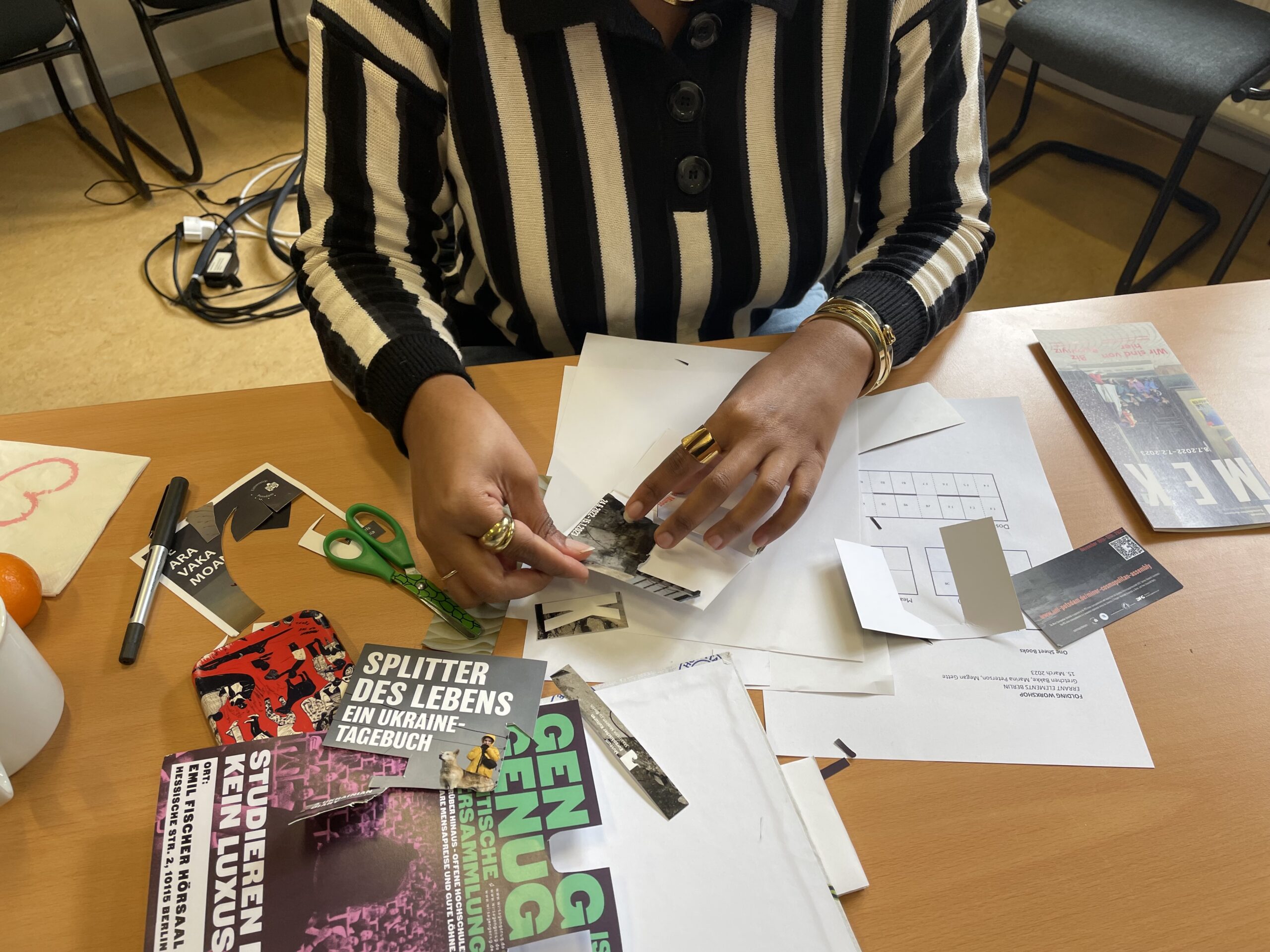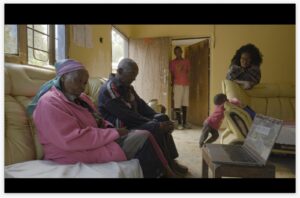Here go our polyphonic reflections on meeting with the Digital Curatorial Collective of the Society for Cultural Anthropology (March 14, 2023).
Judith and Carla
- The workshop opened many directions of thought, and the diversity of the participants, their backgrounds, and ways of working was enormously inspiring.
- The meeting was particularly good at raising and distilling important questions. Why do we decide to work multimodally? Is one reason because they allow us to include certain narratives and representations that are otherwise missing? Is it because existing representations are unsatisfying because they are not really multi-perspectival? Or are they missing something that would make diverse experiences more comprehensible? Why and in what ways is it hard to break with certain narratives while not just remaining critical of them but rather creating and producing something different? How do multimodal approaches help to create these new narratives? Can these narratives only be created through mulitmodality? Comparison between different approaches can become difficult because multimodal productions often need completely different work and research processes and are accompanied by different ways of reflection, representation, and mediation. How does the contribution of a piece reflect on ethical questions through both form and content? How can we reflect upon the decisions that were made to work multimodally, including what kind of technology we use or the aesthetic decisions we take?
- And then there are the media and technological aspects that should be mentioned. What are the strengths and weaknesses of a certain kind of production? It seems in the whole discussion that we kept coming back to this, that it’s so important that we have constant moments of reflection built into the process of working multimodally, particularly on the possibilities and limits of certain ways of knowing, of welding, connecting, montaging, etc. And how are we positioned in these processes, in terms of collaboration and interdisciplinarity, in terms of intersectional awareness and inclusion? Multimodal productions make us think and implement shared authorship in a differentiated and critical way. As an author I present or represent certain knowledge, which in the end is based on my selection and compilation. But as part of a group, the whole production is based on a process of collaborative thinking and creating and can result in a more open-ended thinking. It became obvious that we also have to critically question existing ways of evaluation in academic work, not only for more-than-textual forms but also for written work. We also need to find ways to authorize new ways of evaluation. Learning from other evaluation practices would be helpful, such as curating work in art and film, or jury and commission work in design and architecture. This could be one way that multimodal evaluation can gain authority – by connecting with already existing evaluation traditions in other disciplines. It also seems important to contextualize multimodal works with reference to other works both contemporary and in the past. But this raises questions that we don’t have to ask with text, such as: How do we quote a multimodal work (like a game, or a smell walk)? How do we do an index of such works? The tool kits we want to create should help to implement these two important aspects: to create authority in evaluation by learning from other disciplines and coming up with a bricolage in the evaluation process; and to come up with a convincing consistent way to quote and index multiple works that one can refer to.
Tomás
1) One of the most important things I learnt was that, perhaps, we don’t know what the multimodal ‘can be’, but also, and perhaps more importantly, we don’t know what the multimodal actually ‘is’ or ‘means’: we all agreed to sit around a table for a discussion as if we had a common understanding, but as soon as we started sharing, this couldn’t be farther from the truth: for some, multimodal refers to ‘multi-media’ products (when not transmedia, or using variegated forms of intertextuality), while for others multimodal appears as having to do with ‘experimentation’ or ‘invention’ with the modes in which we do fieldwork, analysis, or representation. Yet another possible meaning of the multimodal is that it’s connected with changes in the conditions of ethnographic work, due to the omnipresence of digital platforms and gadgets changing or even enhancing collaborative conditions of meaning-making, producing records or creating/sharing accounts. Some prefer talking of ‘more-than-textual’ since text can also be multimodal (as in poetry or in peculiar uses of language, where the materiality of a text or a speech can have different dimensions). The multimodal has a strange relation to other multi- categories in anthropology: multi-sensory (not only visual, but also relating to a conversation with the different senses involved, be they as practices or as cultural categories), multi-species (most projects seem to be by/for humans), not to speak of the multiplicity of forms of knowing, sensing and relating (multimodality, or something akin to it, has indeed been the mode of knowing-thinking-doing of our ethnographic counterparts in the past and today) or to multi-temporality of projects. And yet, in this totum revolutum, nothing seems to add up, there are overlaps and non-coherent uses, equivocations and a complex topology of practices that seem to share some similarities, and yet when looked at closely are iridescent, strange, and very different. My sense was that, after all, we might need a chart, a map, or some sort of orienting device to visualize or even show the demarcations, the strange connections, the false friends, and the productive misunderstandings.
2) Another aspect I took from the workshop was that we might need to understand better the conditions of readability and illegibility of what we do when we say we do ‘multimodality’. And there are indeed different publics and emerging counter-publics (to use the felicitous expression from Michael Warner to signal the less conventional and emerging forms of sociality whereby new meanings and conditions of legibility are created) within anthropology and in the neighbouring disciplines or modes of practice (publics of the media and genres we use, anthropological publics, emerging publics, amateur publics). The intriguing thing is that these conditions of legibility, depending on the form, are or are not inscribed in the very media or forms being used: certain kind of genres or modes of doing operate by concealing how they were conceived (e.g. a collage); some others enable layerings of information, even allowing different registers and records to be put together in strange adjacency (e.g. websites). This became relevant when discussing both (i) the relevance of documenting aims, processes and reactions to make sense of what these forms afford; and (ii) the perils of how, when and to what extent these documentary approaches (as anthropologists would tend to do when approaching their own creations) might be ‘explaining away’ what certain forms do while also killing the fun of a peculiar exploration. Making and then describing is an important part, but it also adds a considerable challenge of time and effort.
3) When discussing evaluation, and given that this might require cutting down nuances, and taking decisions, we started talking about works as if they were ‘out there’. Some discussions on the workshop touched upon the slightly positivistic theory of production / creativity / works that such an approach might be putting forward. We know that works are polysemic, that they grow or get transformed in their appreciation, and not just symbolically but in many regards materially, since performance never amounts to perfect repetition. How can we approach appreciation and evaluation from the proliferation of nuance, from the sensitization of nuances, rather than from judgements a priori? Could we judge in a different way if we learnt to appreciate the nuances and singularities of each form? How to do this when forms and genres could proliferate endlessly? (This is a challenge for this project.)
Andrew
The main observation that emerged for me from our meeting was the way that engagement with “multimodality” was being taken as an opportunity to pursue diverse and often disparate goals. Of course, as some have argued, changes in the worlds we research have required us to engage with the more-than-textual productions and mediations of our research participants. But in our meeting, we documented many other motivations. For example, for some, grappling with “multimodality” in publishing has been taken as an occasion to rethink what review and evaluation look like: some experiment with formats like “open review” in which not only are reviewers and reviewed known to each other, but in which the review process is also included in the publication. It can also mean approaching the review process not as an attempt to enforce some disciplinary standard, or perform expertise, but to help creators/authors to realize the potential of their work through an ethic of generosity. It can also mean incorporating different kinds of values into the review process: alongside the values of theoretical innovation, ethnographic creativity, and adding to general knowledge, one can value the affordances of research for the purposes of politics, collaboration/relationship building, critical pedagogy, social repair, public policy, and so on. Note how, strictly speaking, none of these directions in (re)thinking review have to do with multimodality. Other areas in which we can see multimodality being mobilized for adjacent or already existing commitments and goals:
Engaging Sensoria: One clear interest that coincides with the multimodal moment is the desire and possibility to put the fuller sensorium of human experience into ethnographic research, in which the expansion of media is an invitation to an expansion of sensory data captured and evoked, made differently comprehensible, thus breaking down the thinking/feeling binary.
Collaboration: Multimodality is being taken as an occasion to both generate new kinds of research collaborations, but also to give them more visibility. One direction is to invite an engagement with extra-disciplinary expertises and experts. Another is to produce research artefacts that can be circulated to others who can work with them and reveal further affordances and create yet more relations.
Process: Here there are at least two observations: (1) that multimodality, or working beyond the text, offers ways to make the process of research, the kind of reflexivity often favored by anthropologists, and the positionality of those involved in the research process, more palpable, and (2) that some of the value of working in or with more-than-textual means only becomes recognizable if the research process can be made palpable.
Pedagogy: In our discussion, it became clear how much participants valued multimodal research for use in pedagogical contexts, suggesting that we might approach multimodal research less as a publication and more as a curricular device.
**
The picture, taken by Andrew Gilbert, shows a detail of the work of one of the participants in a hands-on workshop (connected with the activities of the DCC in Berlin) hosted by Marina Peterson and Gretchen Bakke on March 15, 2023, where we approached folding methods, collage and other approaches to the DIY making of books.

